In this second and last guest blog post, Kerim Aytac fills in for our hero Ben Street this month. — Ed.
Looking at Richard Nicholson’s elegiac contribution to the Analog show at Riflemaker gallery in London, I couldn’t help but apply my new knee-jerk additive term de rigeur: Porn. His nostalgic but gracious images of the now defunct space of the darkroom are gratuitous, fetishistic even, but are they actually pornographic? Analogue pornographic? Has the term become a substitute for fantasy or escapism, instead of the darker desires the genre is traditionally associated with? Porn is demeaning. Porn is titillating and voyeuristic. Porn is seeing a lot of one thing one is not supposed to want to see, perhaps, but when applied to mainstream filmmaking, for example, it may have come to encompass the fulfillment of a need for the explicit acknowledgment of a pleasure indulged.
Nicholson began to document London’s remaining professional darkrooms in the Summer of 2006, when there were 204 of them. By 2009, only six remained. Only the most masochistic of photographers would truly lament their passing, given the opportunities and ease of use afforded by digital post-production, but many still shoot on film. The images are big, taken with a large-format (film) camera, and pinned to the walls without frames in the manner of the work-print one might find in a darkroom. Their resolution is almost blinding. What is most striking is the aesthetic shift that seems to have occurred during this project. These professional spaces are all controlled chaos with so much stuff needing to be accessed so often, but are a far cry from the minimalist digital workspaces one encounters today. The enlargers are the focal point of most of the compositions, erect and elegant in their dominions, but each is individual in a way that computers rarely are. It has also been surprisingly easy to forget how some spaces were designed for standing before digital ubiquity. Each image represents a sense of the artisanal, a sense of the process. The notes, prints, and clippings affixed to the walls serve as biographical testimony to the many days and months spent occupying these spaces and hint at a lost allegiance to craft over technical mastery. This aspect of image-making has lost its physicality as Nicholson states: “I do miss the aura of the red safelight and the soothing sound of running water. I miss the excited sense of performance.”
Vinyl fetishism amongst music fans is now an accepted form of obsession. It has become a market, albeit small, in its own right. Similar things are happening with photographic film with the demise of various stalwart brands. When Polaroid film was discontinued, a group called The Impossible Project, composed of fans, former Polaroid chemists and employees, set out to manufacture their own versions and have been successful. If major corporations no longer feel the need to manufacture for niche markets, as has become the case with darkroom enlargers, it seems to be up to the hardcore consumer to mobilize. This project doesn’t seem to be a call to this kind of action, however, but is rather more of a eulogy. Nevertheless, one feels a strong desire to inhabit these spaces, to stand in the dark and observe them in use. The trick by which we see these darkrooms in incredible detail and light is alluring, privileged. Gratuitous Process Porn.
First coined by eminent critic David Edelstein, the term “Torture Porn” was used in reference to a sub-genre of horror films in which full-frontal violence became the point. Films like Saw and Hostel were so unashamedly relishing the mutilation on screen, and so honest in their encouragement of the audience to get off on it, that the term gained currency. Later, Eli Roth, director of Hostel, labeled the film Inglorious Basterds as “Jewish Revenge Porn.” Indeed, he gets to the play the part of the man who machine-guns Hitler to death in that movie, and, guilty pleasure though it is, especially when one considers the implications of such brazen historical revisionism, it is very exciting to see. As with “Torture Porn,” the additive term seems to refer to the direct supply of a specific pleasure or a specific desire. This often requires a gratuitous approach: close-ups, lingering takes, exaggerated sound effects, and so on. In other words, porn is now used to describe works that no longer feel the need to disguise the pleasures (base though they may be) they are structured around providing. It may also be a way for audiences to acknowledge their own particular fetishes. Indeed, the Hollywood juggernaut has lost steam. Big budget blockbusters that trade on spectacle have lost any illicit or titillating quality they perhaps once had. Many are bored. What was once rare, like the special effects these films always center around, is now ubiquitous and therefore no longer forbidden. In the same way, Nicholson’s darkrooms are now exotic.
If one looks at this year’s probable Oscar contenders, it could be argued that they are all pornographic in their own way. Big hitter The Social Network, is thrilling “Dialogue Porn” (as was Inglorious Basterds). Essentially a collection of conversational set pieces, the film is almost eroticizing the perfect communicational skills the characters possess. I cannot for the life of me understand why anyone would think this is a negative portrayal of Zuckerberg. I would happily relinquish all my morals and ethics if I could respond to a snooty lawyer accusing me of not listening in the way that he does. As with Hitler’s Jewish-inflicted death, this is pure, unbridled fantasy and vicarious desire fulfilled. The marketing for the film had as its focal point a close-up image of Jesse Eisenberg’s face behind bold lettering, thus foregrounding the film’s emphasis on language. It is, again, full-frontal. It reminds me of Nicholson’s image below.
“Period Porn” has been used mainly in reference to the series Mad Men, probably as a result of its creator Matthew Weiner’s obsessive attention to detail. Weiner was one of the writers on The Sopranos and that show’s creator, Terence Winter, has followed suit with his show Boardwalk Empire. It’s ironic, therefore, that one of the main strengths of The Sopranos was its contemporary setting. Audiences no longer want reality, it seems, but a reality turned up to 11 in a particular direction. The King’s Speech is, apparently, “Period Porn” also, with, again, an emphasis on communication. More interestingly perhaps, is the fervor with which the British middle classes have come to lap this type of film up. The heritage film became one of British Cinema’s key genres, mainly due to its easy exportability to the U.S. The image of Britishness it portrays conforms to many of the stereotypes that, inexplicably, remain. Yet the resounding success of TV series Downton Abbey in the UK, now airing in America, is part of a strange feedback loop. “Period Porn” itself, the show pulls off the amazing achievement of a narrative based on Georgian inheritance laws. As Slate critic Stephen Metcalf argues, a genre that used to be designed for export has now become something the Brits enjoy as much, if not more. Explicit Georgiana, Victoriana, and the Monarchy are now acceptable top-shelf material. Here, the past, devoid of any real strife, is the pleasure. Perhaps this is what appeals so in Nicholson’s work.
Although not released in the UK yet, the general consensus is that one of True Grit’s main appeals is also its use of a deliberate kind of dialogue, so a theme may be emerging here. Dialogue used to be what Hollywood did best. Classics of the Golden Era used scripts as their CGI. Nowadays, the potential to recreate almost anything with computers has trapped mainstream filmmaking. More space needs to be dedicated to the visual. Perhaps, the digital has lost its allure, lost its thrill. All the works to which the term “porn” is applied seem to emphasize the physical in some way, whether it be through talking, costumes, or blood-things beyond the means of the digital. They also, at least this year, emphasize communication, which, without wanting to sound like an old fogey, is perhaps also under threat. Nicholson has tapped into a current in which we have resigned ourselves to the binary, but are fighting to retain the pleasures that once underpinned the culture in which we are embedded. If these are in fact pornographic, than so be it.

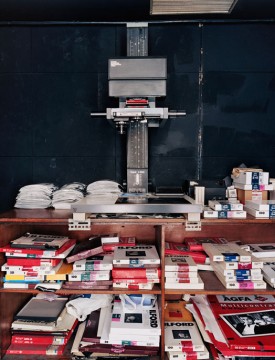
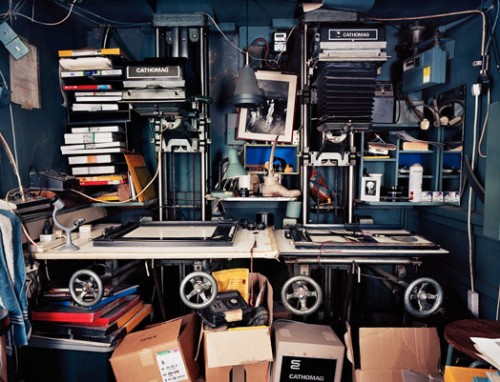
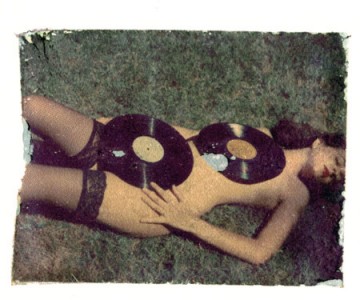
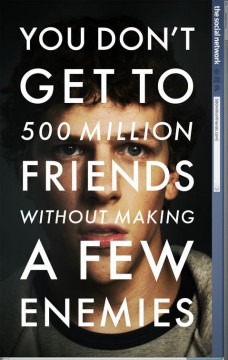

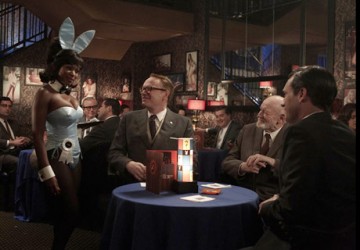



Pingback: Letter from London | Porn, Porn Everywhere: Analog at Riflemaker Gallery. « Besides